| |
Nengajou are traditional New Year's postcards in Japan. They are sent to arrive on or after New Year's Day. It's even considered rather awkward if they arrive early! Late is okay, but it's really best for them to arrive on January 1. For this reason, the post office has a special system set up. When correctly marked as a nengajou, cards are set aside for special handling. Then on New Year's Day, they mobilize thousands of extra employees to deliver all the cards on the same morning. There's a long tradition of handmade cards. In the month before New Year's you can buy blank postcards, which you can decorate by hand with stickers and rubber stamps. You can also use a stencil machine, print them from your computer, or simply draw them by hand. Recently, there are also services in camera shops and on the internet to order your own custom designs. People without such creative inclinations can buy them with pre-printed designs. This year, instead of Christmas cards, we decided to send out nengajou. We used stickers and rubber stamps to decorate ours. A nice feature of making them by hand is that it's easy to make each one unique. 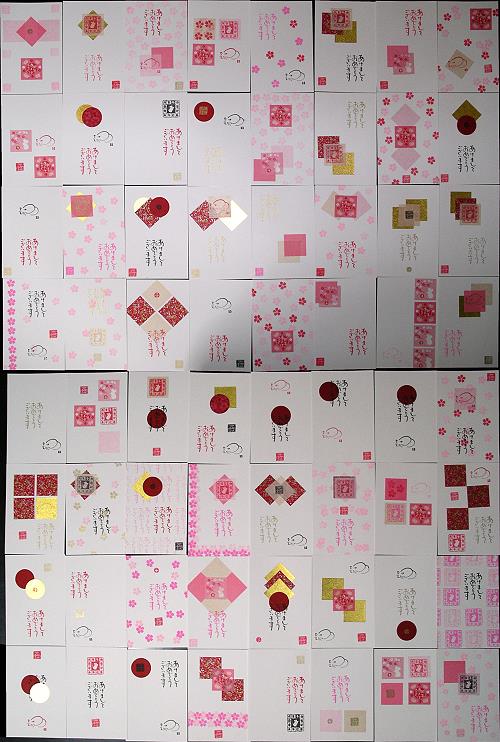 And here's a closeup of one card. 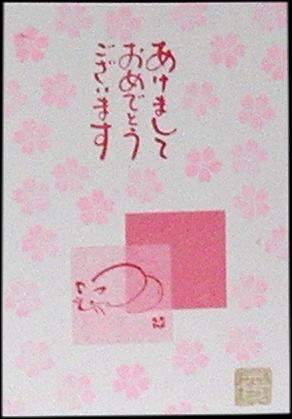 2008 is the "Year of the Rat" on the Asian calendar. There doesn't seem to really be much distinction between mice and rats here (the Japanese word for mouse is actually "small rat"), so it's really treated as the Year of the Mouse. That's why there are all the cute little mice on our nengajou.
[ 4 comments ] permalink
We've both been here long enough to have unusual experiences and eat unusual things. On the eating front, they've almost always been things we've chosen to eat ― nobody really springs freaky stuff on the unsuspecting gaijin. For example, one night at Hige-oyaji's place, he started showing us some more adventurous Japanese foods, including hizunamasu, a Hokkaido regional specialty. Hizunamasu is thin slices of pickled salmon head, cartilage and all. I rather liked it; it makes a nice accompaniment to a mug of beer. He also showed us his big jar of shiokara, which Wikipedia defines as "small pieces of the [sea] animal's meat in a brown viscous paste of the animal's heavily salted, fermented viscera." It's frequently served with shots of sake, perhaps to no one's surprise after that description. We'd gone there a number of times before that night, so we assumed that he'd only busted out the potentially yak-inducing fish preparations because he knew us well enough to know that we wouldn't gag or otherwise freak out. So it was with little or no trepidation that we visited a new-to-us fish restaurant earlier this week. The owner/chef had a pretty standard set of dishes on his menu: nabe teishoku (hotpot served with rice, pickles, and another side of some type); grilled fish teishoku (same thing, but with grilled fish in place of the hotpot and with miso soup); fried fish, maybe an oyster stew. Matthew ordered the seafood nabe teishoku, I went with grilled fish. Things were proceeding as they usually do until we were served. Then the following conversation took place: MAD: I don't know how to eat a whole fish head. SKD: Oh, farm. Is that shiokara? Indeed, on our trays sat little bowls of shiokara, apparently a standard teishoku dish at this restaurant. We ate our other things, glancing at the ruddy brown dish every now and again. Finally, we each bit the bullet and tried it without the benefit of sake because we still had work to do. And. . . it wasn't half bad ― it was quite salty, and tasted rather like fishy miso with bits of squid in it. Mostly, it was a good reminder of what should be the motto for our lives here: expect the unexpected.
Friday, December 14, 2007, 6:08 PM Strange JapanPosted by stefanie Yesterday afternoon, Matthew and I ate lunch at our favorite takoyaki joint and watched the news on Japanese television. At three o'clock, the news broke and a cheery woman at a piano, along with three young women wearing cute gray hoodies and boy shorts, appeared. The woman played the piano while the young women demonstrated a set of stretches, which they then put together as a short calisthenics routine. Nothing terribly taxing, just a bit of exercise, or radio taiso, to get the blood moving after lunch. I had heard about radio taiso from my Japanese teacher in America. It apparently started as an effort by the Japanese government to keep people from being totally sedentary during the day, and continues on NHK. Some companies, like the concrete plant across the street from our house, still do it in the mornings. It does sound like a good way to keep alert and well-stretched ― provided you're not stuffing your face with okonomiyaki at the time it comes on.
Sponge cakes with strawberries, whipped cream, and placards
Cheesecakes with gold dust for holiday snackers
Chocolate yule logs with Santas and sleighs
These are a few of the cakey displays . . . Here in Japan, no Christmas is complete without a Christmas cake. Christmas cake is traditionally sponge cake with whipped cream and strawberries. It has morphed into far more extravagant things, like cheesecakes or chocolate cakes covered in ganache (melted chocolate mixed with cream, and sometimes liqueur). You can also get them decorated with white chocolate Mickey-head plaques or holiday wishes from Kitty-chan. Grocery stores, conbini, and patisseries have had these glossy brochures out for about three weeks now, advertising their scrumptious holiday wares. 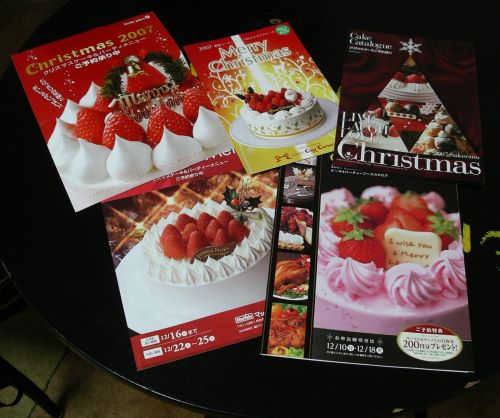
[ add comment ] permalink
Saturday, November 17, 2007, 1:15 AM Strange JapanPosted by stefanie "Okame, kame, kame, uma nat-TOU!"
The music in Japanese grocery stores is insidious. It's not like the Muzak/adult contemporary/soft rock stuff that plays in American grocery stores. It's more like 1970s game show music interspersed with 1950s product jingles, on constant loop. And each store has its own unique selections, further lending to the ambiance of the store (e.g., the JOIS has the checkers wearing mint-green flight attendant uniforms AND sounds like the set of "The Price is Right").
Additionally, there often will be tape recorders scattered throughout the store, eternally playing advertisements for whatever product they're nearest to. The nattou ad at the nearby grocery store is especially fiendish. You say, "I have the nattou song from the Big House stuck in my head," and everyone knows what you mean. And then they sing along.
"Okame, kame, kame, uma nat-TOU!"
[ 2 comments ] permalink
Wednesday, November 7, 2007, 2:11 AM Strange JapanPosted by stefanie I'm afraid of the dark. It doesn't take much to freak me out at night, especially here, where the streetlights are few and far between. On my way to meet Matthew for dinner after work one night, I had a frightening experience that I recall even now, whenever I hear a specific sound.
I was crossing the large street near our house when I first saw the unmarked white truck. It had a red lantern hanging off the back, and played an eerie bamboo flute melody over and over. Low, then high, then low to high again, trilling. It passed me, and I crossed the street, thinking what a curious thing it was. As I walked alone through the darkened streets toward Matthew's office, I heard the melody again. And again. Over and over, low to high, haunting. One street over, the unmarked white truck with the red lantern moved in parallel.
After a few more repetitions of the melody, I started to get nervous. The streets were empty, save for me and the lantern truck. For a city, Kitakami is remarkably quiet, which made the mysterious flute even more unnerving. And it was dark, and the streets were unfamiliar, so I couldn't escape it by choosing an alternate route. I kept moving.
Walking. Red lantern glowing, one street over. Flute playing, haunting, low to high. What was this thing, and why was it stalking me?
By the time I reached the school, my nerves had mostly receded, along with the music. As I told Matthew and his co-worker my scary tale, the music began again, drawing closer. The truck crawled into sight, red lantern glowing, slowing to a stop below the window. It had come:
The mobile ramen shop.
[ 6 comments ] permalink
In America, manhole covers are a largely ignored part of the urban landscape. They are quite plain, bearing little more than a note of what utility it serves and a tread pattern so that pedestrians won't slip. In Japan, though, each municipality has manhole cover designs that reflect local specialties, historical sites, or festivals. Whatever a town is famous for may end up on the manhole covers. Here's one of Kitakami's designs: 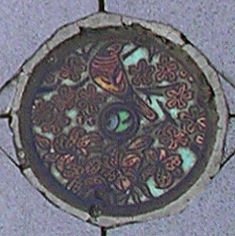 And one from Hottoyuda, famous for its hot springs: 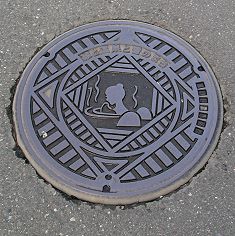 And one from Yokote, depicting Yokote Castle, a kamakura (snow hut), and cherry blossoms: 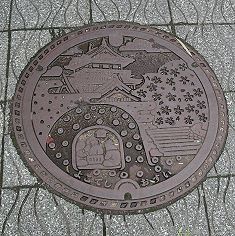
Tuesday, November 6, 2007, 12:37 AM Strange JapanPosted by stefanie Matthew and I finally got around to doing some karaoke together this weekend at a pub/snack downtown. As I understand it, most karaoke in Japan these days occurs in small private rooms (or "boxes") within clubs, rather than out in the open like in America. This pub/snack owner loves music, however, so she has an extensive karaoke setup in the main part of her small establishment ― big screen TV, remote controls with touchpads for researching the listings and reserving songs, and portable mics. Matthew had been here before, during his solo stint in Kitakami, and wanted to return. The owner was friendly, quick with the imo shochu (sweet potato liquor), and insistent upon the karaoke.
With her encouragement, we blew through a diverse selection of songs, including a touching duet on Bon Jovi's "Livin' On a Prayer." There was some Carpenters, there was some Ramones; there was ABBA, there was Heart. If I recall correctly, we did the Doors and the Pet Shop Boys back-to-back. I got up enough courage to do some songs in Spanish. The owner was impressed enough with my "Cielito Lindo" to strongarm me into doing a song with her ― in Portuguese. That did not go so well.
We closed out our set with The Clash, "Should I Stay or Should I Go?" But we had made our decision ― it was time to go.
[ add comment ] permalink
Behold, the kotatsu: 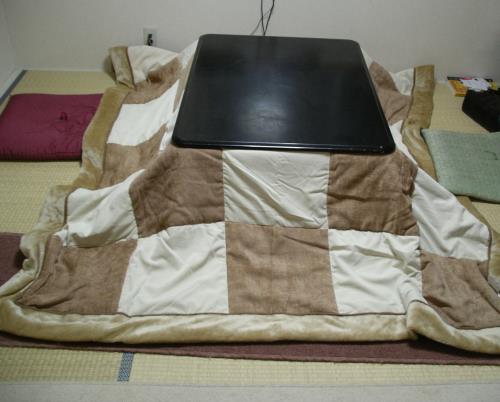 A kotatsu is a low table frame covered by a blanket, which the tabletop sits on. A heat source is located somewhere under the table; ours is electric, and is bolted to the frame. You sit with your legs (or more, if you like) under the blanket, which traps the heat. Like many houses in Japan, ours lacks central heat and much in the way of insulation, so we've stocked up on things like heaters in preparation for the winter. Frankly, even if we had heat, I'd want a kotatsu ― it's all fuzzy and cozy and warm. I hesitate to put this in the "Strange Japan" category, because what it really deserves is an "Awesome Japan" category. I love the kotatsu!
Wednesday, October 17, 2007, 7:18 PM Strange JapanPosted by stefanie There seems to be a lot of road construction in and around Kitakami. Most times that I've been out driving around within the last few weeks, I've encountered lane shifts, diversions, or some other indicia of road work. Unlike Albuquerque, orange barrels don't appear to have much of a presence here.
My favorite construction phenomena, though, are the bowing flagmen. When a two-lane road is narrowed to one for a relatively short distance, a guy with one red and one green flag is stationed at either end of the site. Sometimes, there's even an advance team about 200 yards beforehand holding a sign asking you to slow down (at least, that's what I think it says). If you are the first car in the line that needs to stop, the flagman will wave his red flag at you, then bow when you have stopped. He will bow again before waving his green flag to let you pass through the construction zone. The courtesy makes it hard to be annoyed about any inconvenience. It's so civilized.
[ 2 comments ] permalink
Back Next
|
|









 Calendar
Calendar




